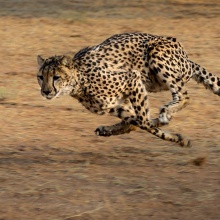An interdisciplinary group of scientists, led by Dr. Michael Günther and Prof. Syn Schmitt from the University of Stuttgart, together with researchers from universities in Koblenz, Cologne and Tübingen, has developed a physical model for exploring the specific characteristics that determine maximum running speed in animals. It also explains why even sprinters at the Olympic games cannot keep up with fast animals.
The Tokyo Olympics are just around the corner, and one of the highlights will be the men’s 100-meter sprint. Top sprinters can reach running speeds of almost 45 km/h. That might sound impressive, but it actually is not when compared to sprinting performance in the animal kingdom – it is only roughly equivalent to the top speed of a domestic cat. Cheetahs can run more than twice as fast (over 100 km/h), while other animals such as antelopes (90 km/h), or even warthogs and hares (just under 60 km/h) could easily outrun human sprinters.
Prof. Syn Schmitt researches at the University of Stuttgart’s Cluster of Excellence Data-Integrated Simulation Science, and his team has investigated the physical and biological factors that have the greatest impact on an animal’s top speed. The research findings were published in the Journal of Theoretical Biology. “This article is the result of years of collaboration between scientists on a personal level, which was met with great interest by editors and constructive consultants at the Journal of Theoretical Biology”, explains Michael Günther. "In terms of content, we were able to use the models and methods explored in SimTech's 'Digital Human Model' and apply them to the animal kingdom. Furthermore, the findings form the foundation for the development of improved, intelligent robotic walking apparatus, which we are aspiring to develop in Cyber Valley," adds Syn Schmitt.
Sprint performance depends on various factors
The core of their theoretical work focuses on the physical balance of propulsive leg force and the air resistance that has to be overcome, as well as the inertia of the propelling muscles. They show a main pathway for changing the structural shape of an animal’s body as a function of body size (allometry), in adaptation to fast leg-driven locomotion. ‘This main pathway describes how the shape of an organism must change as a function of body size in order to achieve a high running speed, and how specific shapes affect the maximum speed that can be achieved,’ said Dr Tom Weihmann from the UoC’s Institute of Zoology.
Fatigue is not the problem
"We were able to disprove that muscle fatigue is responsible for limiting speed in large animals. We recalculated or estimated the metabolic energy supply. The fact that large animals are slower is therefore not due to the lack of energy provided by the organism, but to the inertia of their own mass," explains Dr. Robert Rockenfeller from the university in Koblenz.
However, top speeds depend not only on size but also on body structure, such as the number of legs and the mobility of the spine. For example, many four-legged mammals are able to reach much higher running speeds than bipedal designs such as humans and birds because they can gallop, using their trunk muscles for propulsion. However, if the animals become too heavy, even having more powerful muscles wouldn’t help because larger muscles take more time to contract at top speed. Accordingly, the weight limit above which sprinting speeds start to decrease again is around 50 kg, which is fairly close to the average weight of cheetahs and pronghorns, the fastest sprinters on our planet.
This project was funded by the German Research Foundation (DFG), the Data-Integrated Simulation Science Cluster of Excellence at the University of Stuttgart, and the Baden-Württemberg Ministry of Science (MWK).
Expert Contact:
Prof. Dr. Syn Schmitt, University of Stuttgart, Institute for Modelling and Simulation of Biomechanical Systems, Tel.: +49 (0)711/685 60484, E-Mail
Original publication:
Michael Günther, Robert Rockenfeller, Tom Weihmann, Daniel F.B. Haeufle, Thomas Götz, Syn Schmitt: „Rules of nature's Formula Run: Muscle mechanics during late stance is the key to explaining maximum running speed“ https://doi.org/10.1016/j.jtbi.2021.110714
Video: tinyurl.com/FormulaRun


